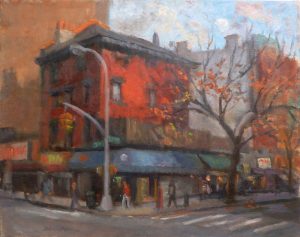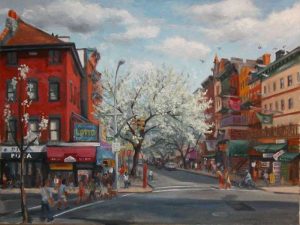23 Third Avenue: An Interesting History and Uncertain Future
If you look at Astor Place and Cooper Square on a map, it looks as though somebody took a lasso and tied a bunch of streets together. Multiple streets and thoroughfares converge and diverge here, and perhaps because of that, this New York City nexus has a long and varied history. One longtime witness to this history is a somewhat quirky but charming building at 23 Third Avenue, also known as 1 St. Mark’s Place.

No. 23 Third Avenue stands alongside two equally old (but less intact) one-story buildings at Nos. 25 and 27 Third Avenue. Currently these three historic buildings are slated to be demolished and replaced by a “boutique office building”. GVSHP wanted to do a little digging into its history; here’s what we came up with.
Determining the date of construction for 23 Third Avenue took some detective work. Property tax records show a house at this location as early as 1829, when the property was owned by William Butler. By 1834 Edmund Wilky had purchased Nos. 23, 25 and 27 Third Avenue (then Nos. 19, 21 & 23 – see maps below), and by 1835 the property value for No. 23 had gone from $2,500 to $8,000, and for Nos. 25 and 27 from $1,800 each to $8,000. This indicates significant improvements to the properties, likely either new, larger buildings being built, or a very significant expansion in the existing buildings.
The house went through some interesting ownership changes over the years. By 1839 Jackson Marine Insurance Company owned and occupied No. 23 and No. 25. Then around 1853, the East River Bank bought 23 Third Avenue. According to an article in The New York Times from May of 1853, the Bank had planned to tear down the existing structure and erect a new banking house. The Bank ran into troubles with its neighbors to the east along St. Mark’s Place when it became known that the building was to be built right out to the property line along St. Mark’s Place. These neighbors had an injunction issued against the bank, alleging that the bank’s plan to build to the lot line was in violation of deed restrictions on the property put in place by the original developer of this end of St. Mark’s Place, Thomas E. Davis. According to the neighbors, when Thomas Davis sold the properties including No. 23 along St. Mark’s Place, all agreements included the mandate that all improvements were to be set back eight feet from the north street line to create a public courtyard. The neighbors further contended that this intention was passed down through subsequent deeds.
The judge found in favor of the neighbors. As a result, according to an 1862 map when No. 23 was extended at the rear, both it and the extension conformed to the required eight-foot setback along St. Mark’s Place. So if you ever wondered why this building has that unusual low brick structure on its south side that sets it back from St. Mark’s Place, that’s why.

As an aside, Thomas E. Davis was responsible for a number of row house developments around the East Village and some of those houses still grace our neighborhood today. Davis developed both sides of St. Mark’s Place (East 8th Street) between Second and Third Avenues. Nos. 4 and 20 St. Mark’s Place, both New York City Landmarks, are intact and also feature the eight-foot setback mandated on the north side of the Street. Another can be seen at 138 Second Avenue which used to be part of a row with Nos. 140 and 142, now the Ukranian National Home.

Studying 23 Third Avenue as it appears today provides some more information about its construction date. Under the multiple layers of paint, one can discern that the brick is set in a Flemish bond pattern, typical of the Federal style (1790-1835). The rest of the building is very much in keeping with the Greek Revival style (1830-1855) including the parlor floor windows, the garrison windows below the roof eave, and the hipped roof itself which most likely originally extended over Nos. 25 and 27 (that’s right; the little one-story buildings that once housed the Continental Club and a McDonald’s were probably originally mid-1830s houses like No. 23). Per an alteration permit from 1884, the parlor floor of No. 23 was lowered to the sidewalk level and presumably, the stoop was removed. Based on this evidence plus the history described above, it seems as though No. 23 Third Avenue was constructed in 1834-35.


By 1876, 23 Third Avenue was home to the Astor Place Hotel. Suffice it to say that the Astor Hotel had a somewhat less than wholesome reputation, as did much of this area in the late 19th century (the Bowery, which began here, had become New York’s Skid Row, and a noisy, dark, elevated train line ran overhead). Newspaper articles between 1876 and 1904 included stories of a child abandoned there by her mother, a fifteen-year-old runaway who had been abandoned there by her lover, attempted (and successful) suicides by guests, guests dying of a gas leak, an arrest of counterfeiters at the hotel, a guest who swindled passersby and was arrested, and a housekeeper of the hotel who was charged with attempted murder of her lover. In 1920, a permit was filed by the cigar store at the first floor to extend the first floor out the eight feet that were denied to East River Bank.
23 Third Avenue has long caught the eye of locals and visitors as it stands at the gateway to the East Village at the start of St. Mark’s Place. This includes local painter Patricia Melvin, who has generously allowed GVSHP to use these two paintings of the buildings she made, the first pictured above and the other pictured here:

Click HERE to see other works by Patricia Melvin.
Just recently GVSHP staged a rally in front of 23 Third Avenue calling for the Mayor and the City to change the zoning for the Third and Fourth Avenue corridors to limit the development by the rapidly encroaching tech industry. To learn the latest news on our efforts, click HERE. To send a letter to the Mayor, click HERE, to send a letter to Manhattan Borough President Gale Brewer, click HERE and to send a letter to your Elected Officials, click HERE urging them all to support re-zoning for Third and Fourth Avenues.

Here’s a nice mid-50’s view…